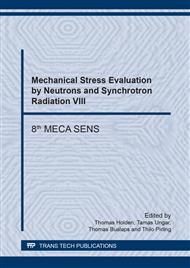p.46
p.52
p.60
p.66
p.74
p.83
p.91
p.101
p.107
Lattice Strain Pole Figures Analysis in Titanium during Uniaxial Deformation
Abstract:
A theoretical and experimental study was carry out to investigate deformation mechanisms in a textured titanium alloy. In situ neutron diffraction measurements were performed to analyze different {hk.l} family planes ({10.0}, {10.1}, {11.0} and {00.2}) and determine the corresponding internal strain pole figures. This method was applied to a pure titanium (a-Ti) submitted to a uniaxial tensile load up to 2 %. The experimental data was then used to validate the EPSC model in order to predict the distribution of lattice strains determined by neutron diffraction for various diffraction vector directions. This comparison reveals that the model results were in good agreement with the experimental data and the simulations reproduced the lattice strain development observed on the strain pole figures determined by neutron diffraction.
Info:
Periodical:
Pages:
74-80
Citation:
Online since:
August 2017
Authors:
Price:
Сopyright:
© 2017 Trans Tech Publications Ltd. All Rights Reserved
Share:
Citation:


